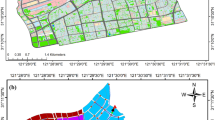Abstract
An optimal drainage tunnel location determination method for landslide prevention was proposed to solve the existing problems in drainage tunnel construction. Current applications of drainage tunnel systems in China were reviewed and the functions of drainage tunnel were categorized as catchment and interception. Numerical simulations were conducted. The results show that both catchment and interception tunnels have variation of the function in the simulation of monolayer model, which shows the reduction of permeability condition in lower layer. The function of catchment can be observed in the deep slope, while the function of interception is observed near groundwater source. By using the slope safety factor and discharge water amount as the objectives of optimal drainage tunnel location, and pore-water pressure in fixed node and section flux as the judgment for construction quality of adjacent drainage tunnel, the design principle of drainage tunnel was introduced. The K103 Landslide was illustrated as an example to determine the optimal drainage tunnel location. The measured drainage tunnel efficiency was evaluated and compared with that from the numerical analyses based on groundwater data. The results validate the present numerical study.
Similar content being viewed by others
References
CHEN Jian, YANG Zhi-fa, LI Xiao. Relationship between landslide probability and rainfall in Three Gorges Reservoir area [J]. Chinese Journal of Rock Mechanics and Engineering, 2005, 24(17): 3052–3056. (in Chinese)
TERLIEN M. The determination of statistical and deterministic hydrological landslide-triggering thresholds [J]. Environmental Geology, 1998, 35(2/3): 124–130.
CHO S, LEE S. Instability of unsaturated soil slopes due to infiltration [J]. Computers and Geotechnics, 2001, 28(3):185–208.
COLLINS B, ZNIDARCIC D. Stability analyses of rainfall induced landslides [J]. Journal of Geotechnical and Geoenvironmental Engineering, 2004, 130(4): 362–372.
SCHMERTMANN J. Estimating slope stability reduction due to rain infiltration mounding [J]. Journal of Geotechnical and Geoenvironmental Engineering, 2006, 132(9): 1219–1228.
RAY R, JACOBS J, ALBA P. Impacts of unsaturated zone soil moisture and groundwater table on slope instability [J]. Journal of Geotechnical and Geoenvironmental Engineering, 2010, 136(10): 1448–1458.
RAHIMI A, RAHARDJO H, LEONG E. Effect of antecedent rainfall patterns on rainfall-induced slope failure [J]. Journal of Geotechnical and Geoenvironmental Engineering, 2011, 137(5): 483–491.
RAHARDJO H, NIO A, LEONG E, SONG N. Effects of groundwater table position and soil properties on stability of slope during rainfall [J]. Journal of Geotechnical and Geoenvironmental Engineering, 2010, 136(11): 1555–1564.
CAI F, UGAI K. Numerical analysis of the stability of a slope reinforced with piles [J]. Soils and Foundations, 2000, 40(1): 73–84.
KOURKOULIS R, GELAGOTI F, ANASTASOPOULOS I, GAZETAS G. Slope stabilizing piles and pile-groups: Parametric study and design insights [J]. Journal of Geotechnical and Geoenvironmental Engineering, 2011, 137(7): 663–677.
MONTGOMERY D. Road surface drainage, channel initiation, and slope stability [J]. Water Resources Research, 1994, 30(6): 1925–1932.
PHILLIPS L, SCHUMM S. Effect of regional slope on drainage networks [J]. Geology, 1987, 15(9): 813–816.
CAI F, UGAI K, WAKAI A, LI Q. Effects of horizontal drains on slope stability under rainfall by three-dimensional finite element analysis [J]. Computers and Geotechnics, 1998, 23(4): 255–275.
COJEAN R, CAI Y. Analysis and modeling of slope stability in the Three-Gorges dam reservoir (China): The case of Huangtupo landslide [J]. Journal of Mountain Science, 2011, 8(2): 166–175.
GHIASSIAN H, GHARCH S. Stability of sandy slopes under seepage conditions [J]. Landslides, 2008, 5(4): 397–406.
SUN Hong-yue, Shang Yue-quan. Groundwater effect on landslide and its control along Shangyu-Sanmen highway in Zhejiang Province [J]. Chinese Journal of Rock Mechanics and Engineering, 2006, 25(3): 505–510. (in Chinese)
SHEN Xiu-ping. Measurement in treatment of Pinganting tunnel landslide in Huaan Hydrolic power plant [J]. Fujian Hydroelectric Engineering, 2001(2): 15–26.
ZHANG Ai-jun, KANG Shun-xiang, ZHANG Shao-hong, XIAO Dang-qi. 3D seepage numerical analysis of loess landslide body at Bojishan in Baoji city [J]. Journal of Hydroelectric Engineering, 2005, 24(5): 60–64. (in Chinese)
ZHANG Zuo-chen, Mechanism of groundwater effect landslide stability and control construction [J]. Journal of Engineering Geology, 1996, 4(4): 80–85. (in Chinese)
CHEN Chong-xi, CHENG Jian-mei. A new idea about drainage pattern in landslide prevention and treatment: By example of Huanglashi landslide at the Three Gorges [J]. Earth Science, Journal of China University of Geosciences, 1998, 23(6): 628–630. (in Chinese)
SUN Hong-yue, WONG L, SHANG Yue-quan, SHEN Yong-jiang, LV Qing. Evaluation of drainage tunnel effectiveness in landslide control [J]. Landslides, 2010, 7(4): 445–454.
MA Liang-cheng, ZHENG Gui-bin. Reinforcement and treatment to high slope in hydroelectric engineering in China [J]. Journal of Hydroelectric Engineering, 2000, 19(1): 34–37. (in Chinese)
ZOU Cheng-jie. The effect of rockmass shear dislocation on the stability of slope [J]. Chinese Journal of Rock Mechanics and Engineering, 1997, 16(4): 312–319. (in Chinese)
LIN Xi-he. Long deep highway landslide disaster action mountain and treatment project countermeasures [J]. Fujian Architecture and Construction, 2011(2): 67–69. (in Chinese)
SHARMA R, NAKAGAWA H. Numerical model and flume experiments of single- and two-layered hillslope flow related to slope failure [J]. Landslides, 2010, 7(4): 425–432.
GENUCHTEN V. A closed-form equation for predicting the hydraulic conductivity of unsaturated soils [J]. Soil Science Society of America Journal, 1980, 44(5): 892–898.
Author information
Authors and Affiliations
Corresponding author
Additional information
Foundation item: Project(1220BAK10B06) supported by the National “Twelfth Five-Year” Plan for Science & Technology Support Program of China; Project(20100101110026) supported by the PhD Programs Foundation of Ministry of Education of China; Project(2009R50050) supported by the Key Innovation Team Support Fund of Zhejiang Province, China
Rights and permissions
About this article
Cite this article
Wang, Zl., Shang, Yq. & Sun, Hy. Optimal location and effect judgment on drainage tunnels for landslide prevention. J. Cent. South Univ. 20, 2041–2053 (2013). https://doi.org/10.1007/s11771-013-1706-5
Received:
Accepted:
Published:
Issue Date:
DOI: https://doi.org/10.1007/s11771-013-1706-5



